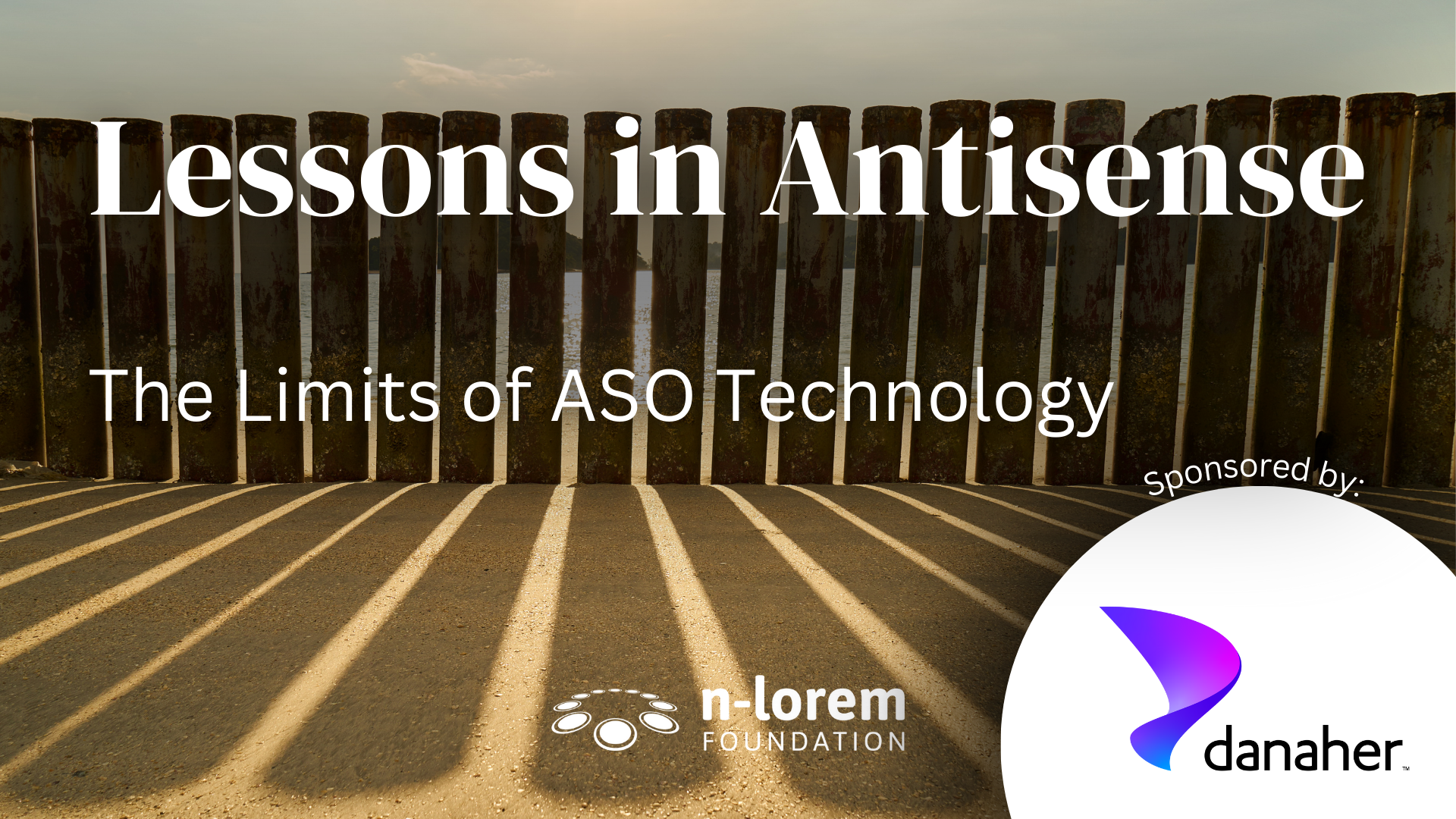Lessons in Antisense
Lesson 18 – The Limits of ASO Technology
September 8, 2025 by Dr. Stan Crooke

Introduction
To my mind, the most productive way to think about the limits of any drug discovery technology, including antisense, is to divide the limits into three groups: Limits that are intrinsic to the basic properties of the technology and are unlikely to be solved, limits that are likely to be quite challenging to overcome and limits that seem amenable to solutions based on technologies available today. I particularly like this approach as a means of prioritizing investments.

Emergent and acute indications
Compared to other classes of drugs, the kinetics of phosphorothioate (PS) ASO drug action are quite slow. Thus, it seems unlikely to me that PS ASOs will ever be useful in emergent situations such as cardiogenic shock or pulmonary emboli. Similarly, PS ASOs are unsuited to acutely anti-coagulate patients, to treat hypertensive emergencies or to induce anesthesia. Nor do I think PS ASOs are likely to be useful in acute viral infection-associated emergencies.
Bacterial infections
Bacteria are protected by a cell wall. PS ASOs are 6-7KD water soluble amphipathic molecules and numerous efforts have shown that the bacterial cell wall is highly effective at preventing PS ASO entry. Further, the onset of action of PS ASOs is too slow to be ideal for the treatment of bacterial infections and the price might be prohibitive compared to small molecule drugs.
Minor psychiatric disorders
For the foreseeable future, to be active in the CNS, PS ASOs must be given intrathecally. This disqualifies them from being used to treat anxiety or minor affective disorders.
Null mutations
True null mutations result in the loss of production of an essential protein. Homozygous null mutations require the replacement of the gene or repair of the defective gene. Heterozygous null mutations may be amenable to ASOs designed to up-regulate translation, but this is somewhat challenging to do today.

Replacing the sugar-phosphate linkage
In 1989, I defined ASOs in which the sugar-phosphate linkage is replaced with more attractive moieties as “third generation” ASOs. Several features made such chemicals attractive, including ease of synthesis, diversity of chemical solutions, the ability to vary charge both globally and positionally and solution phase manufacturing to name a few. Thus, when peptide nucleic acid (PNA) chemistry was invented and demonstrated a significant increase in RNA affinity, we immediately licensed the technology and invested at least a decade in trying to understand the basic properties of PNA ASOs and creating a wide array of PNA analogs. Despite the high affinity for RNA and the obvious opportunities presented by altering splicing and arresting translation and years of effort, we were unable to show antisense activity in cells or animals. We hypothesized that PNAs were inactive because they did not distribute to tissues or within cells, but we showed that even if tissue and sub-cellular distribution were improved, no reproducible antisense activity was observed. Nor did any of the scores of PNA like modifications work. We still do not understand why, but recently a company that is reputed to be focused on PNAs was founded, so perhaps they will solve this mystery.
Replacing phosphorothioates
The major benefit of PS modifications is that they provide optimal protein binding. Despite the success of PS modifications, there are issues such as cytotoxicity, innate immune activation, chirality and manufacturing challenges that suggested that replacing some or all PS moieties might be valuable. Once again, we invested a great deal in looking for alternatives, but failed to identify any attractive solution.
Systemic delivery of PS ASOs to the CNS
Though I am extremely skeptical about the feasibility of safely delivering PS ASOs repeatedly to the CNS systemically rather than intrathecally, we have invested here and failed. Today, there is enthusiasm for systemic CNS delivery via transferrin receptors. I am dubious. The challenge that concerns me most is delivering PS ASOs repeatedly without inadvertently delivering other molecules that could produce severe side effects such as meningitis or inflammation due to delivery of antigens or immune stimulants. I am also concerned about the disruption of iron homeostasis with long-term use. I also think that systemic doses will need to be quite high resulting in systemic toxicities and prohibitive costs. To my mind, the most tractable solution is to extend the duration of effect in the CNS, thus resulting in semi- or annual intrathecal (IT) dosing.
Targeted delivery to organs other than the liver and cells other than hepatocytes
The success of GalNAc conjugation to enhance total delivery of siRNAs to the liver and hepatocytes and productive delivery of PS ASOs to hepatocytes has imbued an optimism that one can target delivery to other organs and cells that I do not think is justified. What tends to be overlooked is that the liver’s job is to sample every drop of blood and extract process xenobiotics from blood. Its anatomy and vasculature are specialized to assure that can be done and hepatocytes are equipped with multiple scavenger receptors like the asialoglycoprotein receptor that binds GalNAc moieties. These receptors are expressed in large numbers on hepatocytes and rapidly cycle via endosomal processes resulting in high-capacity delivery to hepatocytes of ligand they bind.
In contrast, other tissues and cells have systems that are highly selective in the types of molecules that they will accept. Today, there is a good bit of enthusiasm for antibodies and cyclic peptides that enhance delivery of PS ASOs to skeletal muscle and that approach may enhance treatment of diseases of skeletal muscle at relative high doses, but I doubt whether the delivery to cardiac tissues will be sufficient to treat other than the most severe cardiac diseases. I am more encouraged by glucagon-like peptide (GLP)-1 analog-conjugated PS ASOs delivery to beta cells of the pancreas, but this too will take more work. Productive delivery to lymphoid cells, bone, the gut and other tissues will be very challenging.
Commercially attractive oral delivery
I thought we had enabled commercially attractive oral delivery to the liver of GalNAc PS ASOs by enteric coating pills and using C10 (sodium caprate) as a penetration enhancer, but was proved wrong when we conducted long-term toxicology studies and encountered nephrotoxicity secondary to gut microbial toxins that also entered when we opened gut tight junctions with C10. To succeed, safer ways to enhance absorption repeatedly will need to be found.
Solid cancers
Solid cancers present unique challenges for the technology about which we still have a very limited understanding. My best guess is that we need to solve two issues that affect delivery of sufficient concentrations of PS ASOs to all the tumor and tumor associated cells necessary. First, as cells dedifferentiate, they lose in plasma membrane integrated proteins required for productive uptake of PS ASOs. Indeed, they may lose entire pathways. This has been repeatedly observed in primary cancer cell lines, in transformed lines and in patient-derived cells as we passage them. Since the bulk of productive delivery of PS ASOs is via endosomal processes, one wonders whether these processes are perturbed in cancer cells. Cancer cells may present a need and opportunity to try to take better advantage of the sulfhydryl exchange uptake process since cysteine containing proteins must still be expressed on cell surface. The second issue is the delivery of bulk PS ASO to an entire solid tumor cell population. We know that solid tumors undergo neovascularization, but we do not know how that affects PS ASO distribution in solid cancers. We also know that most solid cancers are poorly vascularized, often necrotic centers to which PS ASOs distribute poorly. However, such areas often have dormant cells that regenerate the tumor and become chemo resistant. In short, we must kill a higher fraction of all cancer cells, including those that are poorly vascularized. These two problems, I think, mean that we have too low a fractional kill rate in solid cancers and thus we may see some limited activity, but it is insufficient. Additionally, we know that the stroma and interstitium are different, and we have no idea how that affects PS ASO distribution within a cancer. Further, multiple non-cancer cells participate in the growth of cancers in vivo. Once again, we simply know too little about PS ASO distribution to those cells.

Reducing the risk of Cytotoxicity
Our work has paved the way to avoid or reduce the risk of cytotoxicity by point modifications in the gap. Mesyl-phosphonate modifications appear to one optimal chemical solution.
Up-regulation of translation
Once again, our work was pioneering in this area, but recent advances in basic research have provided the tools needed to make up-regulation of translation more facile and robust.
Reducing the risk of innate immune activation
A solution to reduce the risk of PS ASO-induced innate immune activation is not immediately in hand, but our work on the molecular mechanisms of PS ASO induction of innate immunity and how innate immune activation by PS ASOs is terminated is pointing the way to potential solutions. If this effort is successful, it would likely enable aerosol delivery of PS ASOs to move forward as well.
Enhancing allele-selectivity
Today we identify allele-selective ASOs with a bulk screening approach that is inefficient and sometimes fails. However, recent advances in RNA biology may provide the tools to create a more facile approach.
Conclusions
As is the case with any drug discovery technology, antisense technology has limits. It is important to consider limitations in the context of intrinsic or immutable limitations or limitations potentially amenable to technological advances. The kinetics of PS ASO effects are intrinsic to the basic process, including the need to distribute to tissues and enter cells, then to hybridize to the target RNA sequence, which, in turn, leads to pharmacological effects. Consequently, I think it unlikely that technology will ever be of use in acute medical emergencies. Similarly, any immutable biological characteristic that makes it impossible for a PS ASO to enter a cell makes it unlikely that technological advances will correct the problem. Consequently, I think it unlikely that PS ASOs will be useful in treating bacterial infections.
In contrast, there are challenges that are theoretically amenable to advances in the technology; some of which may be more rapidly corrected while others may take much more time. Certainly, the most significant limitation of the technology, the inability to be agonist-like, seems likely to yield to advances reasonably rapidly. In contrast, problems for which all the biological factors causing the limitations are not understood, such as delivery of PS ASOs to cancer cells may take longer.

We cannot do
this alone
Together we are changing the world—
one patient at a time
We hope that you join us on this journey to discover, develop and provide individualized antisense medicines for free for life for nano-rare patients. The ultimate personalized medicine approach – for free, for life.
Follow us on social for updates on our latest efforts


